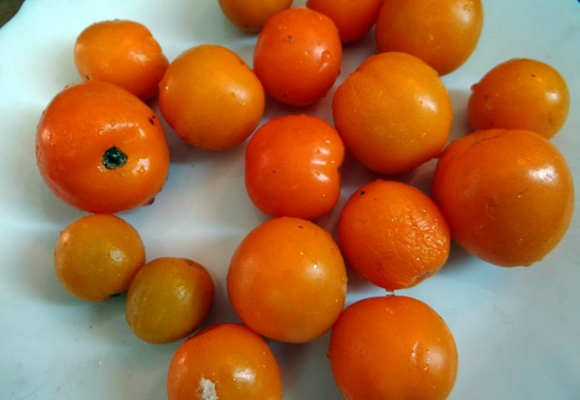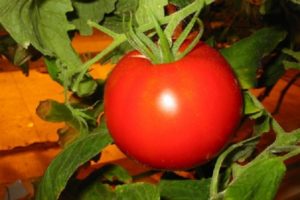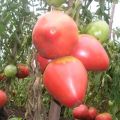Characteristics and description of the Mandarinka tomato variety, its yield
Dreaming of a good harvest of tomatoes, gardeners are experimenting with different varieties. The Mandarin tomato appeared on the vegetable market not so long ago, but has already gained popularity among lovers of nightshade crops.
A few words about the new variety
If you decide to start quickly ripening tomatoes on your land plot, then you should take a closer look at the Mandarinka variety. Its main advantages are early maturity, yield, disease resistance, and its main characteristic is a pleasant taste.

This tomato is intended for planting in a greenhouse, as it loves heat and sunlight, and is afraid of sudden changes in temperature. Mandarin duck is an indeterminate variety. This means that the bush, in comfortable conditions for it, does not stop its growth, having formed up to 8 clusters of fruits. In height, it grows up to 1.8 m under the very roof of the greenhouse.
All this time, new branches with tomatoes continue to be tied on it. For this feature, the plant is called carpal.
Mandarin tomatoes lay the first inflorescence when 9-10 leaves bloom on the trunk. In the future, the ovaries are stably and consistently formed after each 3rd leaf, on one brush there can be up to 10 of them. Bushes begin to bear fruit 90-100 days from the moment of germination. The fruits have the following description:
- color is bright orange;
- round shape;
- the taste is sweet.

The yield of Mandarin duck is about 5 kg from each bush, and the average weight of one tomato is 95 g. As the photo shows, a greenhouse with ripe fruits resembles a citrus garden, in which numerous tomatoes are full of red dots among green foliage. For its resemblance to tropical fruits, the variety got its name.
About planting fruitful tomatoes
More than one experienced gardener planted Mandarin tomato with seeds in boxes with heated soil in early March. Seedlings can be grown both at home and in a greenhouse. The first time watering with water at room temperature is carried out after the sprouts hatch from the ground. After 14 days, the seedlings are watered again. Every day, boxes with seedlings must be turned towards the sun so that everyone gets the same amount of light.
When the seedlings reach a height of 25 cm, they can be planted in a permanent place. This usually happens in early May.
Anyone who has planted tomatoes in a greenhouse knows that the soil for young plants should warm up well. The optimum soil temperature is + 15 ° C. The beds 40 cm high and 80 to 100 cm wide are recommended to be done a week before the tomatoes are planted. The soil should contain turf, peat or humus, a little sand. 1 bucket of peat is poured onto 1 m² of sod beds, the same amount of humus. You can add 1 tbsp to the soil. l. superphosphate. Everything is dug up and left to warm up.
Young plants should be planted on a garden bed in two rows in a checkerboard pattern, observing a distance between rows of 60 cm and between seedlings of 30-40 cm.Dug holes 30 cm deep and 20 cm wide, add 1 glass of wood ash to each of them and 1 liter of potassium permanganate solution.
3 days before planting in the greenhouse, 3 lower leaves are removed from each plant. Such a procedure will help the first brush to form faster and will be an obstacle to the development of diseases from which nightshade crops suffer. A few hours before planting in the holes, seedlings are watered abundantly with warm water.
When planting, a young tomato is carefully placed in a prepared hole, the roots are straightened, and the plant itself is given an upright position. If the seedlings have managed to outgrow, it is advisable to plant it in a different way. First, dig a hole 12 cm deep, make another hole in it to the height of the pot or lump of soil in which the seedling developed. When planting, a young plant of the Mandarinka variety is placed in the lower hole and sprinkled on it. The superior fossa remains open for 12 days. After the seedlings take root, the hole is also sprinkled with soil.

How to care for nightshades in a greenhouse
2-3 days after planting, the tomato must be tied to a peg, which is driven into the ground next to the bush at a safe distance from its root system. You need to periodically monitor the stem and replace the old pegs with higher ones as it grows. It's better tie up tomatoes to wire or rope trellises located under the greenhouse roof. A timely tie to the supports is very beneficial for tomatoes.
Every experienced gardener knows that if she grows tomatoes on trellises, all ovaries will receive more sunlight and oxygen, which will lead to an increase in yield. And the leaves raised on the supports will avoid contact with wet soil, so they will not get sick.
A distinctive feature of the Mandarinka variety is the formation of a plant into one stem. It involves the removal of all unnecessary stepchildren that begin to form on a young bush shortly after it is planted in the greenhouse. The procedure is performed in the early morning (at this time, excess shoots break off more easily) in sunny weather (this helps the plants to tighten the wounds faster). Stepsons can be cut with garden shears or removed by hand. In order not to infect, the scissors are disinfected in a solution of potassium permanganate after each circumcision. Hands break off any stepson to the side.

Monitor the condition of the stem, remove stepchildren in a timely manner, because they take the nutrients it needs from the main plant. Do not let the plants bush and form a lot of greenery. It is better to remove all the lower leaves. And under the brushes with fruits they should not be at all.
While the plants have not bloomed, they are watered once every 5 days. Water is poured at least 4 liters per 1 m². During flowering and ovary formation, tomatoes require abundant watering: from 10 to 12 liters per 1 m². Top dressing is carried out 3 weeks after transplanting. Take 1 tbsp for a bucket of water. l. nitrophoska and 2 tbsp. l. The ideal is liquid fertilizer. A mixture in the amount of 1 liter is poured under each bush. The second feeding is carried out 10 days after the first.
Observing all the conditions necessary for growing Mandarin tomato, you will get a rich harvest of fruits, reviews of which can only be heard positive.









